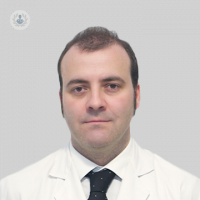Detection and treatment of prostate cancer
Written by:What is prostate cancer and what factors cause it to appear? Can it be prevented?
Prostate cancer is the most common tumor in men and third in mortality after lung cancer and colorectal cancer. It is a hormone-dependent tumor, specifically testosterone. Its genesis has no relation to this hormone, but its treatment.
The factors that cause it to appear are still to be determined, as it is not related to tobacco or other toxic risk factors. A few years ago it was speculated on the possible relationship vasectomy could have with the onset of cancer , but could not be confirmed.
A known risk factor is obesity , as cholesterol metabolism is clearly related to the onset of this cancer. For this reason the preventive measures for this type of tumor would be the general hygienic dietary measures, without being shown the protective effect of any particular factor (for example pumpkin pipes).
What techniques and advances have been developed to detect this type of cancer?
The early diagnosis of this tumor is one of the fields where the most advanced, thanks to a marker such as PSA (Prostate specific antigen) that has allowed to detect this type of tumors before and the possibility of offering curative treatments.
The diagnosis of this tumor is always made by prostate biopsy. This is indicated by the PSA, its absolute value, its relation to the free PSA, its kinetics, etc.
Much progress has been made in this regard to improve the diagnosis. On the one hand we have molecular diagnostic techniques that allow us to further fine tune biopsy indications, such as urine (PCA3) and blood tests (PSA Score, ProPSA). On the other hand imaging techniques, such as prostate magnetic resonance imaging , and improvements in prostate biopsy provide us with earlier and more accurate detection of tumors.
What treatments and techniques are used to combat it?
There are different treatments that we divide into premises, or with curative intention, and systemic, with intention to control the cancer.
Within the curative intention we find two fundamentally: surgery and radiotherapy .
The surgery is done in 3 different ways, open or traditional, laparoscopic or robotic. It consists of the excision of the prostate and seminal vesicles, and also of the lymph nodes (lymphadenectomy) when indicated. The nerves of the erection will be preserved in the indicated cases.
There are no differences in cancer outcomes between the 3 techniques, but in the rate of blood transfusion, which is greater in open surgery, as well as recovery, which is faster with non-invasive techniques.
The most frequent complications are impotence and incontinence , which depend on the experience of the surgeon.
Radiation therapy can be external, via an electron accelerator, or interstitial ( Brachytherapy ), by permanent implantation of radioactive seeds in the prostate.
The side effects of radiation therapy, as in surgery, are impotence and incontinence, as well as other radiation-related complications such as cystitis and radic rectitis , as well as urethral stenosis .
Other options are energy treatments such as cryotherapy, HIFU (high intensity ultrasound) and Irreversible Electroporation. These are minimally invasive local treatments. They are currently undergoing experimentation and we only know results in the short and medium term.
As systemic treatments we have hormone therapy and chemotherapy .
Hormone therapy consists of chemically castration of the patient to suppress testosterone.
What is the current prognosis for prostate cancer patients?
The prognosis of prostate cancer depends mainly on the stage of the cancer and its degree of differentiation. The cases differed in 3 large groups: low, intermediate and high risk , according to PSA, Rectal Taste, and Gleason grade of the biopsy. These groups give us a lot of information about the evolution that these patients will have.
The prognosis of patients in the low-risk group is excellent, and the chances of dying from prostate cancer are, in these cases, very low. In contrast, for high-risk patients, expectations are worse, and they are likely to need more treatments in the future.



